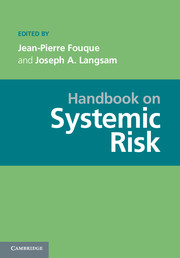Book contents
- Frontmatter
- Contents
- Contributors
- Introduction
- PART I DATA: THE PREREQUISITE FOR MANAGING SYSTEMIC RISK
- PART II STATISTICS AND SYSTEMIC RISK
- PART III MEASURING AND REGULATING SYSTEMIC RISK
- PART IV NETWORKS
- PART V SYSTEMIC RISK ANDMATHEMATICAL FINANCE
- 14 Firms, Banks and Households
- 15 An Agent-Based Computational Model for Bank Formation and Interbank Networks
- 16 Diversification in Financial Networks may Increase Systemic Risk
- 17 Systemic Risk Illustrated
- 18 Financial Crisis and Contagion: A Dynamical Systems Approach
- PART VI COUNTERPARTY RISK AND SYSTEMIC RISK
- PART VII ALGORITHMIC TRADING
- PART VIII BEHAVIORAL FINANCE: THE PSYCHOLOGICAL DIMENSION OF SYSTEMIC RISK
- PART IX REGULATION
- PART X COMPUTATIONAL ISSUES AND REQUIREMENTS
- PART XI ACCOUNTING ISSUES
- References
15 - An Agent-Based Computational Model for Bank Formation and Interbank Networks
from PART V - SYSTEMIC RISK ANDMATHEMATICAL FINANCE
Published online by Cambridge University Press: 05 June 2013
- Frontmatter
- Contents
- Contributors
- Introduction
- PART I DATA: THE PREREQUISITE FOR MANAGING SYSTEMIC RISK
- PART II STATISTICS AND SYSTEMIC RISK
- PART III MEASURING AND REGULATING SYSTEMIC RISK
- PART IV NETWORKS
- PART V SYSTEMIC RISK ANDMATHEMATICAL FINANCE
- 14 Firms, Banks and Households
- 15 An Agent-Based Computational Model for Bank Formation and Interbank Networks
- 16 Diversification in Financial Networks may Increase Systemic Risk
- 17 Systemic Risk Illustrated
- 18 Financial Crisis and Contagion: A Dynamical Systems Approach
- PART VI COUNTERPARTY RISK AND SYSTEMIC RISK
- PART VII ALGORITHMIC TRADING
- PART VIII BEHAVIORAL FINANCE: THE PSYCHOLOGICAL DIMENSION OF SYSTEMIC RISK
- PART IX REGULATION
- PART X COMPUTATIONAL ISSUES AND REQUIREMENTS
- PART XI ACCOUNTING ISSUES
- References
Summary
Abstract We introduce a simple framework where banks emerge as a response to a natural need in a society of individuals with heterogeneous liquidity preferences. We examine bank failures and the conditions for an interbank market to be established.
We start with an economy consisting of a group of individuals arranged in a 2- dimensional cellular automaton and two types of assets available for investment. Because of uncertainty, individuals might change their investing preferences and accordingly seek their surroundings neighbors as trading partners to satisfy their new preferences. We demonstrate that the individual uncertainty regarding preference shocks coupled with the possibility of not finding suitable trading partners when needed give rise to banks as liquidity providers. Using a simple learning process, individuals decide whether or not to join the banks, and through a feedback mechanism we illustrate how banks get established in society. We then show how the same uncertainty in individual investing preferences that gave rise to banks also causes bank failures. In the second level of our analysis, in a similar fashion, banks are treated as agents and use their own learning process to avoid failures and create an interbank market.
In addition to providing a bottom up model for the formation of banks and interbank markets, our model allows us to address under what conditions bank oligopolies and frequent banks failures are to be observed, and when an interbank market leads to a more stable system with fewer failures and less concentrated market players.
Information
- Type
- Chapter
- Information
- Handbook on Systemic Risk , pp. 401 - 431Publisher: Cambridge University PressPrint publication year: 2013
References
Accessibility standard: Unknown
Why this information is here
This section outlines the accessibility features of this content - including support for screen readers, full keyboard navigation and high-contrast display options. This may not be relevant for you.Accessibility Information
- 3
- Cited by
